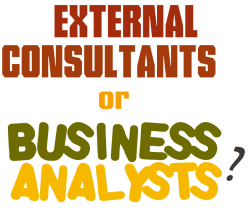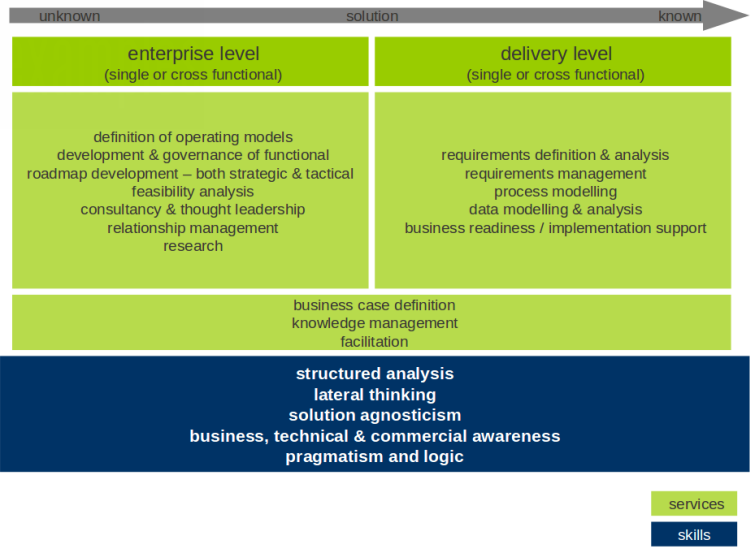Abstract
Many organisations hire external consultants with no experience of their business to shape strategies and propositions. In doing this, they are unconsciously ignoring internal resource with exactly the same skills but additional knowledge and experience of the business – namely their Business Analysts. BAs have a unique skillset, offering holistic insight, analysis and recommendations.
As well as structured analysis, BAs offer facilitation and modelling, identify people, process and technology impacts and document operating models and roadmaps.
This article presents real-life experience in moving BAs further up the lifecycle to work with key stakeholders in shaping strategy, defining propositions and challenging business models.
Organisations often hire external consultancies to perform activities such as feasibility studies, cost/benefit analyses and facilitation, or to benefit from their cross-industry expertise. They can be brought in for their strategic thinking capability, or to define an operating model.
However, these engagements often come at a very steep price – and what many organisations fail to spot is that they often have exactly the same capability within their organisation already, namely the Business Analysis team.
An organisation's Business Analyst team will have much the same capability as an external consultant. Indeed, some of your BAs may have worked for one or more of the big consultancies in the past – a quick assessment of my last 3 employers' BA teams included ex-employees from IBM, Accenture, Cap Gemini, HP and Logica.
As well as the cost downsides of using an external provider, there are other downsides. For example, although the consultancy may have experience with similar engagements in the past, will they actually provide the people who worked on those engagements? Or will you get a team of recent graduates armed with little more than access to an intellectual capital database? Will you get independence? Many consultancies are tied to particular vendors or technologies, or will deliberately recommend solutions that they have experience in deploying rather than what is best for your organisation. And will they just re-purpose work that your staff has already done, presenting it as their own?
 As well as having the same skills as external consultants, BAs offer something in addition that they will never be able to compete with; organisational context. BAs occupy a unique position within the organisation, having cross-functional visibility of change and an understanding of how the organisation works. This is not just related to the processes and technology in use, but also the people – who the key decision makers are, who the influencers are and how the internal networks of people operate. In short, BAs de-risk business change in a way that external consultants can never replicate.
As well as having the same skills as external consultants, BAs offer something in addition that they will never be able to compete with; organisational context. BAs occupy a unique position within the organisation, having cross-functional visibility of change and an understanding of how the organisation works. This is not just related to the processes and technology in use, but also the people – who the key decision makers are, who the influencers are and how the internal networks of people operate. In short, BAs de-risk business change in a way that external consultants can never replicate.
Having this knowledge of the business means BAs can add extra value – for example by identifying opportunities to share resource across similar initiatives, whether people or funding. They also bring knowledge of what's been tried before, what has and hasn't worked. Furthermore, they may bring relevant knowledge of other industries or even your competitors.
|
BAs can identify:
proposed changes that conflict with already committed projects
to wasting of money and duplication of effort
proposed solutions that do not fit with strategic roadmaps
to wasting of money
poorly constructed business cases
to wasting of money and increased risk
obvious synergies that are not being exploited
leading to wasting of money
|
|
BAs offer
- operating model definition
- strategic analysis
- feasibility studies
- cost/benefit analysis
- roadmap definition, facilitation and mapping
|
Case study 1
 One business unit wanted to deploy SharePoint, and were planning to go ahead with a single deployment just for their use and therefore sized accordingly. The BA who was working on this project was aware of other business areas that would be interested in using this application but the first business unit didn't want to spend the extra money necessary to scale up the deployment to accommodate them. None of the other departments had the funding necessary to contribute to a full deployment – therefore it looked like we were going to end up with a siloed deployment of an enterprise application.
One business unit wanted to deploy SharePoint, and were planning to go ahead with a single deployment just for their use and therefore sized accordingly. The BA who was working on this project was aware of other business areas that would be interested in using this application but the first business unit didn't want to spend the extra money necessary to scale up the deployment to accommodate them. None of the other departments had the funding necessary to contribute to a full deployment – therefore it looked like we were going to end up with a siloed deployment of an enterprise application.
To prevent this from occurring, the BA actively surveyed other areas of the business to confirm and qualify their interest as well as capture their specific needs – not just how they wanted to use SharePoint but also identifying areas they may not have thought of where the application could offer benefit. Based on the results of this activity, the BA then proposed a cost model to the original department that involved them paying to scale up the platform but benefiting from subsequent adopters paying an annual fee for its use (through the organisation's existing internal charging model). Part of this fee would be used to cover “sales” activity from the BA team whereby they would actively promote the availability of the platform to other departments. This sales activity focused on knowledge management, drawing on the organisation's strategy on this subject so that the SharePoint application didn't just become another dumping ground.
Case study 2
The marketing team within the organisation were developing a new proposition and had engaged the BA team to help shape and scope the initiative at a pre-project stage.
One of the BAs on this team had previously worked on a very similar proposition at a competitor. The BA was able to use this experience to explain to the marketing team what had and hadn't worked for the competitor in question, as well as how long the competing project had taken to develop.
The result of the BA bringing this directly relevant experience to bear was that the marketing team had the opportunity to redefine the proposition upfront, long before any money was spent defining or building the actual product.
Case study 3
One part of the organisation had implemented a strategic correspondence management platform, and created a team to manage it. Another part of the organisation was defining their strategy and independently decided that they wanted to improve the way that they managed their customer correspondence – and proposed setting up a team to manage it. Thus the organisation would have ended up with two different teams, effectively doing the same thing...
Fortunately, the BAs that had been assigned to facilitate the development of the correspondence strategy were aware of the existence of the first team and proposed that they be used as part of the overall correspondence operating model. As part of this activity, the BAs facilitated the definition of a service and cost model to ensure that the existing team could adequately support the second business unit; this work developed into a definition of the overall strategy relating to correspondence management across the organisation.
The Enterprise Analysis framework

The BA team provides different services, which are provided by different resources dependent on capability, knowledge, experience and preference – they are both sides of the same coin however, and are built on a foundation of common skills and behaviours. Some BAs may regularly move from one end of the scale to the other, depending on skills, demand and aspirations. The key thing to note about this framework is that the resources involved are all BAs – no matter what end of the scale they work at; the model is based on leveraging skills that already exist within the organisation.
However, not everyone is suited to working, or wants to work, at the enterprise end of the scale. There are particular characteristics of the successful enterprise analyst such as:
- The ability to think both strategically and tactically. Not just either/or but simultaneously. For example, being able to consider tactical options that take the organisation on a tangent away from the strategic roadmap but which allow joining up again in the future. Also being able to challenge a decision on a project that has been taken to go down a strategic route for technology reasons but that isn't the best option for the business at that point in time.
- Dealing with ambiguity. Not just the everyday ambiguity of requirements elicitation but being able to cope with ambiguous strategic objectives and conflicting executive behaviours.
- Knowing when to challenge – and when not to.
- Being able to rationalise ambiguity within one's own mind – the classic Orwellian “doublethink”.
- Business and technical expertise. One on its own isn't enough. The BA doesn't have to be infallibly excellent in either of these areas but crucially, they need to be credible; technology people will expect the BA to understand their world and explain the business side to them – and vice versa.
- Looking at things holistically. Again, this is about credibility - BAs performing in the enterprise space need to be able to look at the entire organisation, the industry it operates in and in some cases other industries as well. This is where active research and knowledge management pays dividends, and is one area that the big consultancies do very well. However there is no reason why this can't be replicated internally if given the right focus – you'll be surprised how quickly a usable knowledge base can be assembled by a dedicated team.
Marketing
So you've identified the right people, assembled a knowledge base...but where does the work come from?
If you're lucky, some of it will present itself without much work but just like the big consultancies the BA team has to let people know what they can do, and a marketing plan should be a key aspect of the function. If you don't tell your customers what you can do, then they will go elsewhere – perhaps to providers they've worked with before, or those they play golf with...
The marketing plan should comprise several different elements:
- Services map. Simply put, this is what you do and how you offer it to the market. It needs to be concise and easy to understand; a one-pager is ideal. This helps to frame the overall proposition and gives you a framework that can be used to market individual services.
- Example deliverables for each of your services, to be provided either on request or to support a pitch
- Procurement checklist. Optional, but if you have a contracts or procurement team (this may be part of Finance) that are responsible for approving 3rd party engagement contracts, you should let them know about the internal capabilities that you have. One way of doing this is to provide a checklist of services and keywords that they should check contract requests for so that they can challenge back to the business sponsor when presented with a request to engage a 3rd party. They can be a key ally in making the organisation consider looking for skills internally before engaging a consultancy. Note that this doesn't have to be limited to Business Analysis or Change skills – it could be an opportunity to encourage the procurement team to assess what other skills are present internally that the organisation is paying external providers for, such as those in Accountancy or HR.
- Objectives. This is a critical part of any marketing plan and when setting objectives you should consider the following:
• do the BAs understand the proposition?
• do your customers understand the proposition?
• do you know who your key customers are and should you treat some differently from others?
• how are you going to measure the success of the enterprise analysis framework?
Conclusion
The one-liner message from this article is this: organisations shouldn't spend money externally when they already have skilled internal resource that can do the same thing for less; however, the organisation may need to be told that these capabilities exist.
 Author: Joseph da Silva has been a Business Analyst for over 10 years; currently working for British Gas, he is also co-founder of www.pragnalysis.com, a website dedicated to pragmatic business analysis techniques and the home of a free requirements toolkit.
Author: Joseph da Silva has been a Business Analyst for over 10 years; currently working for British Gas, he is also co-founder of www.pragnalysis.com, a website dedicated to pragmatic business analysis techniques and the home of a free requirements toolkit.
Licensed under a Creative Commons Attribution-Share Alike 2.0 UK: England & Wales License.